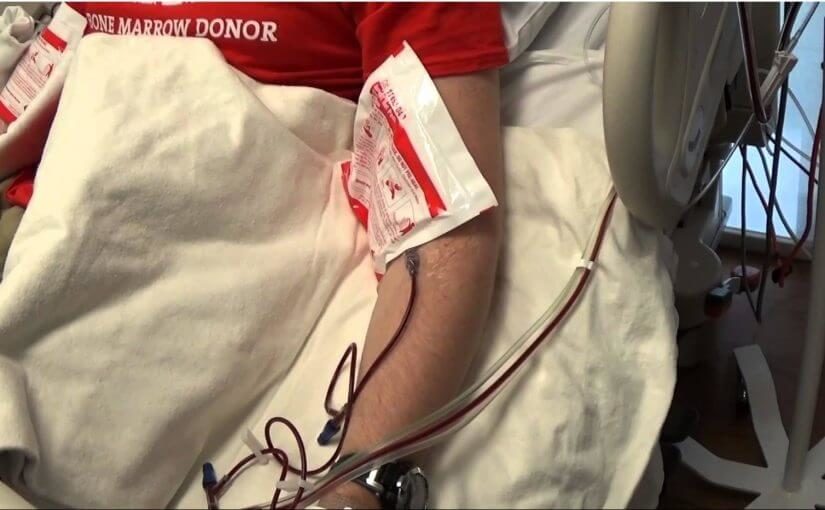People aged between 18 and 45 are being urged to sign up to save a life by joining the Australian Bone Marrow Donor Registry (ABMDR).
The ABMDR helps people who need bone marrow and stem cell transplants because of blood cancers, genetic disorders and immune conditions.
Pathology plays a vital role in bone marrow donation. Becoming a registered donor involves giving a blood sample at an Australian Red Cross Blood Service centre. Pathology teams test donors’ blood to find out their human leukocyte antigen (HLA) tissue type and this information is stored by the ABMDR.
HLA are proteins that your immune system uses to recognise which cells belong in the body and which do not, so a donor must be carefully selected to minimise risk to the patient. HLA typing is more complex than blood typing, making matching donors to patients more difficult.
Only around 30% of patients will match with a family member and as 34 people a day are diagnosed with a blood cancer, the ABMDR needs as many donors as possible.
Unfortunately finding a match can also be affected by ethnicity – a person is more likely to find a match with someone who shares their ethnic background. As 80% of people registered as donors are of ‘Northern Caucasian’ backgrounds, people of other ethnicities may be left with little hope of finding a lifesaving match.
Ur the Cure is an organisation set up to promote the ABMDR and particularly to raise awareness of the need for donors from a range of ethnic backgrounds, to help people like Melissa Baker who has Italian heritage.
Melissa is a Victoria-based Forensic Pathologist who understands the value of pathology for both professional and personal reasons – she has a stubborn form of Hodgkin’s Lymphoma.
In June 2013, Melissa noticed some small lumps in her neck. With her medical background she suspected lymphoma, which was verified by pathology tests. According to Lymphoma Australia, Melissa is one of the 5,000 cases of lymphoma that are diagnosed in Australia each year.
“Believe it or not, I’ve been told that I’m ‘lucky’ because Hodgkin’s Lymphoma is a ‘good’ cancer to get as there is a high chance of remission and cure. That’s not helpful, especially in light of the fact that I underwent 15 gruelling months of chemotherapy including an autologous stem cell transplant, which is a transplant using my own stem cells, but my cancer did not respond as hoped. I then tried a new drug which unfortunately wasn’t subsidised by the government’s Pharmaceutical Benefits Scheme.”
The new drug cost Melissa, a single mum of two young children, $10,600 per treatment. With the support of her family, friends and Lymphoma Australia, Melissa raised money to help her, and hopefully others in a similar position, pay for the expensive treatments.
“After an initial good response, unfortunately my lymphoma began to progress again after nine treatments. I am now waiting for a clinical trial to open so I can access a new type of drug that will use my own immune system to fight the cancer. The hope is that I will have a good response and consolidate that with another stem cell transplant, this time using donor stem cells. My last hope for a cure is finding a compatible donor, but so far a world-wide search for a donor has not been successful. It is easy to join the bone marrow and stem cell registry – you can be added when you donate blood with the Australian Red Cross Blood Service. I plead with anyone donating blood to join the registry to help me and others like me.”
Despite the difficulties Melissa has faced, she is adamant about the value of pathology in getting her this far and has hope for the future with the drug and donor stem cell transplant.
“The diagnosis via biopsy gave my doctors and I the information we needed to plan my treatments. Throughout it all, I have had regular pathology tests to monitor my ongoing health.”
The Ur the Cure campaign is using social media to spread the word and get more potential donors, you can like and share the Facebook page to help get the message out.
Founder of Ur the Cure, Pamela Bou Sejean is keen to dispel common misconceptions about donating stem cells; “Donating stem cells is easier these days, it’s much like a blood donation where your stem cells can be taken straight from the bloodstream. The non-surgical procedure can take about 4 hours and you can watch TV or read a book during it and return to normal activities afterwards. Pretty simple considering you could save a life!”
Pamela points out that only 1 in 1500 Australians in any given year is a match and will be asked to donate stem cells.
To learn more about becoming a bone marrow donor, visit http://www.abmdr.org.au/
To join the ABMDR call the Red Cross Blood Service on 13 14 95 and book an appointment – you will need to specifically mention the ABMDR.
To support Melissa through her fundraising with Lymphoma Australia, visit http://www.everydayhero.com.au/event/igotthegoodcancer

